<< Previous | Displaying results 4376-4400 of 6769 for "" | Next >>
[This video is silent] German forces entered Warsaw in September 1939. The next month, they ordered the establishment of a Jewish council (Judenrat) in the city. They chose Adam Czerniakow, a member of Warsaw's old Jewish Community Council, to lead it. Here, for German newsreels, a German propaganda company stages a meeting between Czerniakow and petitioners from the ghetto. The Germans expected Czerniakow to implement German orders, including demands for forced labor and confiscations of Jewish-owned…
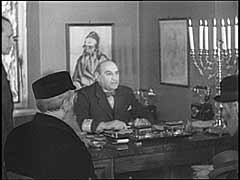
Beginning in 1941, the Germans deported Jews in Germany to the occupied eastern territories. At first, they deported thousands of Jews to ghettos in Poland and the Baltic states. Those deported would share the fate of local Jews. Later, many deportation transports from Germany went directly to the killing centers in occupied Poland. In this footage, a German propaganda unit films recent arrivals from Magdeburg, Germany, in a collection center run by the Jewish council in the Warsaw ghetto. In July 1942,…
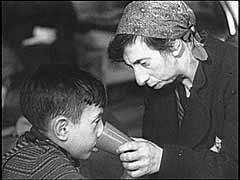
Germany invaded Poland on September 1, 1939, beginning World War II. German forces swiftly overran Polish border defenses and approached Warsaw, Poland's capital city. Warsaw suffered heavy air attacks and artillery bombardments during the campaign. The city surrendered on September 28. This footage shows German forces entering Warsaw amidst the destruction caused by their bombardment of the city.
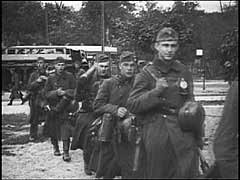
Germany invaded Poland on September 1, 1939. The Blitzkrieg ("lightning war") campaign in Poland was short and decisive. Warsaw, the capital of Poland, surrendered on September 27. In early October, Adolf Hitler visited Warsaw to review his forces. This footage shows victorious German army units parading before Hitler in the streets of the devastated city.
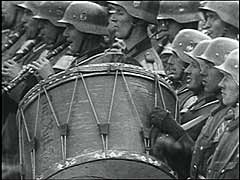
A pogrom took place in Kielce, Poland, in July 1946. Forty-two Jews were massacred and about 50 more were wounded. The event touched off a mass migration of hundreds of thousands of Jews from Poland and other countries of eastern and central Europe. This clip shows Jewish refugees, survivors of the pogrom, waiting to leave Poland and crossing into Czechoslovakia.
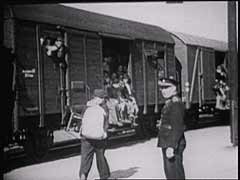
After World War II, the Allies repatriated millions of displaced persons (DPs) back to their countries of origin. But hundreds of thousands of people, including more than 250,000 Jewish refugees, could not or would not return. Most Jewish DPs preferred to leave Europe for either Palestine or the United States. The United Nations Relief and Rehabilitation Administration (UNRRA) housed them in camps in occupied Germany and Austria until they could be resettled. Here, Jewish DPs raise their children in the…

After World War II, the Allies repatriated millions of displaced persons (DPs) to their countries of origin. But hundreds of thousands of people, including more than 250,000 Jewish refugees, could not or would not return. Most Jewish DPs preferred to leave Europe for either Palestine or the United States. The Allies housed them in camps in occupied Germany until they could be resettled. Here, Jewish Zionists protest their continued confinement in Zeilsheim displaced persons camp in Germany. They demand…
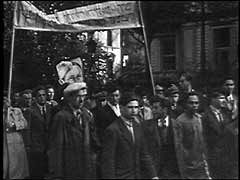
At the end of World War II, the Allied powers in Europe repatriated from Germany millions of displaced persons (DPs). The remaining 1.5 to 2 million DPs—both Jews and non-Jews—refused or were unable to return to their prewar homes. Immigration restrictions precluded the large-scale admission of these refugees to other European countries and the United States. They remained in occupied Germany until they could arrange to settle in another country. In this footage, filmed more than four years…
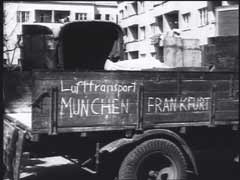
German Einsatzgruppen operated in German-occupied territories in eastern Europe during World War II. This rare footage shows a unit during a massacre in Liepaja, Latvia. The film was taken, contrary to orders, by a German soldier. Before the war, the Jewish population of Liepaja stood at more than 7,000 residents. Einsatzgruppen shot almost the entire Jewish population of the town. When the Soviet army liberated the city in 1945, just 20 to 30 Jews remained. Einsatzgruppen carried out various security…
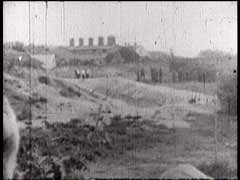
In July 1944, Soviet forces liberated the Majdanek extermination camp. The Polish-Soviet Nazi Crimes Investigation Commission, established to document Nazi atrocities committed during the German occupation of Poland, ordered exhumations at Majdanek as part of its efforts to investigate Nazi mass killings in the camp. The commission later published its findings in Moscow on September 16, 1944, in Polish, Russian, English, and French.
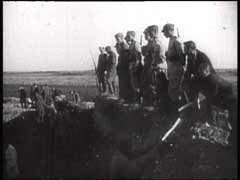
Soviet military footage showing children who were liberated at Auschwitz by the Soviet army in January 1945.
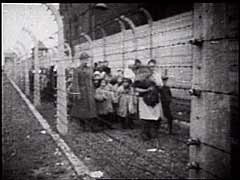
The Dachau concentration camp, northwest of Munich, Germany, was the first regular concentration camp the Nazis established in 1933. About twelve years later, on April 29, 1945, US armed forces liberated the camp. There were about 30,000 starving prisoners in the camp at the time. Here, soldiers of the US Seventh Army document conditions in the camp. They also require German civilians to tour the camp and confront Nazi atrocities.
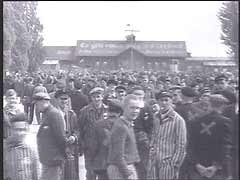
[This video is silent] There were three large forced-labor camps in Hannover, a large industrial city in northern Germany. All three of the camps were part of the Neuengamme concentration camp system. In early April 1945, American forces entered Hannover and freed the surviving prisoners. The American Signal Corps filmed one of the Hannover camps soon after liberation. American forces fed survivors of the camp and required German civilians to help bury the dead.
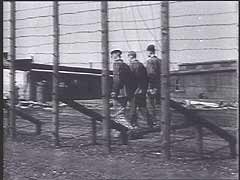
This film footage is excerpted from documentary film titled "Mauthausen Concentration Camp," showing footage from both Mauthausen and the nearby Gusen camp. Filmed by US cameramen, the footage opens with a broad view of buildings in the Gusen camp. Excerpts that follow show scenes in the camps, American care of the liberated prisoners, and Austrian civilians loading bodies of victims onto carts for burial.
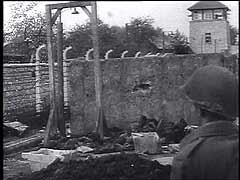
The German western campaign into the Low Countries and France shattered Allied lines. Within six weeks, Britain evacuated its forces from the Continent and France requested an armistice with Germany. Paris, the French capital, fell to the Germans on June 14, 1940. In this footage, triumphant German forces raise the swastika flag over Versailles and over the Eiffel Tower in Paris. Versailles, the traditional residence of French kings, was deeply symbolic for the Germans: it was the site of both the…
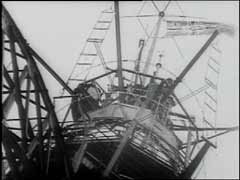
On the night of November 14-15, 1940, almost 500 German bombers attacked the British industrial city of Coventry in central England. The bombers dropped 150,000 incendiary bombs and more than 500 tons of high explosives. The air raid destroyed much of the city center, including 12 armament factories and the historic Saint Michael's Cathedral. This footage shows scenes from the aftermath of the attack. The bombing of Coventry came to symbolize, to Britain, the ruthlessness of modern air warfare.
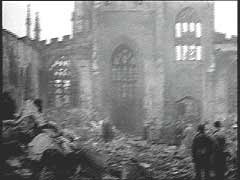
While Japanese diplomats in Washington, DC, negotiated with Secretary of State Cordell Hull, Japanese planes bombed the naval base at Pearl Harbor. American outrage at the surprise attack overcame isolationist sentiment and the United States declared war on Japan the following day.

Portion of the speech in which President Franklin D. Roosevelt asked the US Congress to declare war on Japan following the previous day's surprise attack on Pearl Harbor.
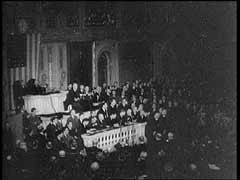
World War II began with the German invasion of Poland in September 1939 and ended in Allied victory in Europe with the German surrender in May 1945. May 8 was proclaimed VE (Victory in Europe) Day. In this footage, United States president Harry S. Truman proclaims victory in Europe and promises to continue the war in the pacific until the unconditional surrender of Japan.
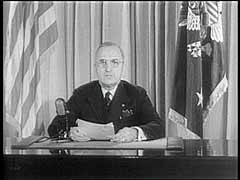
After the Munich agreement and the Czech surrender of the Sudetenland to Germany, German authorities expelled these Jewish residents of Pohorelice from the Sudetenland to Czechoslovakia. The Czech government, fearing a flood of refugees, refused to admit them. The Jewish refugees were then forced to camp in the no-man's-land between Bruno and Bratislava on the Czech frontier with Germany.
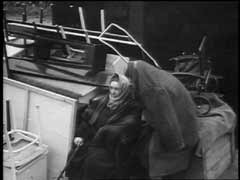
Delegates of 32 countries assembled at the Royal Hotel in Evian, France, from July 6 to 15, 1938, to discuss the problem of Jewish refugees. The refugees were desperate to flee Nazi persecution in Germany, but could not leave without having permission to settle in other countries. The Evian Conference resulted in almost no change in the immigration policies of most of the attending nations. The major powers--the United States, Great Britain, and France--opposed unrestricted immigration, making it clear…
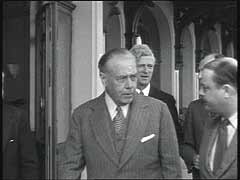
The postwar movement of about 250,000 mainly eastern European Jewish survivors to displaced persons camps and to the West, with the goal of reaching Palestine, was known as the "Brihah" ("flight"). Here, Jewish refugees cross illegally into Italy, probably to charter a ship to sail to Palestine. The British restricted Jewish immigration into Palestine and deported "illegal" immigrants to detention camps in Cyprus.
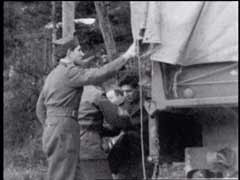
After the defeat of Germany, the Allies tried leading state and party officials and military commanders of the Third Reich before a tribunal of military judges from the Soviet Union, Great Britain, France, and the United States. This International Military Tribunal tried 22 major war criminals during what is commonly known as the Nuremberg Trial, which lasted from November 1945 to October 1946. This footage shows the accused entering pleas following their indictment on charges of crimes against peace, war…
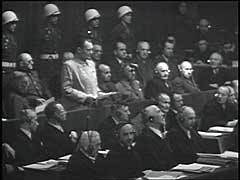
Hermann Göring was head of the German air force. He was one of 22 major war criminals tried by the International Military Tribunal at Nuremberg. Here, Göring testifies about his order of July 31, 1941, authorizing Reinhard Heydrich, head of the Reich Security Main Office, to plan a so-called "solution to the Jewish question in Europe." The Tribunal found Göring guilty on all counts and sentenced him to death. Göring committed suicide shortly before his execution was to take place.
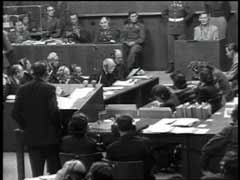
The Medical Case was one of 12 war crimes trials held before an American tribunal as part of the Subsequent Nuremberg Proceedings. On trial were doctors and nurses who had participated in the killing of physically and mentally impaired Germans and who had performed medical experiments on people imprisoned in concentration camps. Here, concentration camp survivors Maria Kusmierczuk and Jadwiga Dzido, who had been victims of these experiments, show their injuries to the court as evidence.
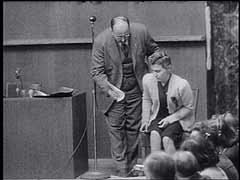
We would like to thank Crown Family Philanthropies, Abe and Ida Cooper Foundation, the Claims Conference, EVZ, and BMF for supporting the ongoing work to create content and resources for the Holocaust Encyclopedia. View the list of donor acknowledgement.